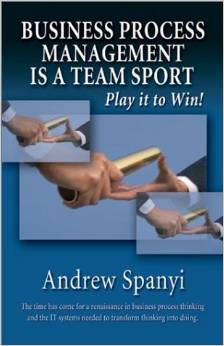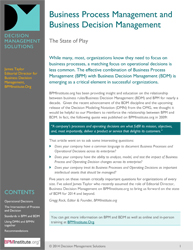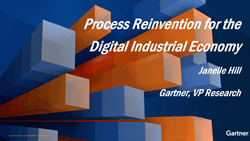Home / Resources
Resources
Discover a Wealth of BPM Knowledge and Expertise at BPMInstitute.org!

Difficult People in the Virtual World – (part 2 of The Virtual Team Facilitator)
Difficult people can disrupt any meeting, and we all know their frequent styles and behaviors from face-to-face meetings. These are people such as the Heavy Talker, the Technical Expert, and the Know It All. Below are some more difficult people that apply in the virtual meeting. (Of course many of these roles apply in the face-to-face meeting as well.)
The Late Comer. You need to have the virtual tool set up at least 15 minutes ahead for a long meeting (over 2 hours) and 10 minutes before for a shorter meeting. Welcome people as they come on. Then at the start time, tell everyone you will start now or wait for 2 more minutes, and then start. When new people come in, welcome them and move along.

The Consequences of BPM without BDM
When BPM is pursued without pursing Business Decision Management—BDM—in parallel the direct consequence is that decisions become an afterthought in the processes that need them. In contrast, applying BDM techniques and technologies in parallel means that decisions are identified, managed and improved distinct from processes resulting in increased agility, simpler processes and improved consistency.
The risks of failing to manage processes and decisions are:

Change – Too Much of a Good Thing?
Agile. Continuous Improvement. The Virtuous Cycle. It’s true – change is necessary, and we all need to get better at adapting to change at an ever-more rapid pace. The increase in the pace of change in today’s world is exponential.
No one wants to get stuck in analysis-paralysis while the competition moves on without us, and there’s nothing wrong with experimentation and trying new things. However, it does sometime seem that changes are made for the wrong reasons, and not driven by pro-active, intentional movement towards goals. We’ve all seen decisions made without the necessary due diligence, and often those are compounded over and over as companies shoot from the hip, reactively trying to fix (or cover) their original mistake.

Requirements at the Speed of Business
How many of you have heard the statement “The project failed because we didn’t have good requirements”? I’ve heard it dozens of times. It doesn’t matter whether it’s from seasoned project teams or ad hoc teams. The single biggest reason for project failure is a problem with the requirements. Even with agile processes in place, I see the same things repeated over and over. In doing post-mortems on projects that failed and projects that succeeded I have found some common traits.

Evolving From Human-Centric to Social-Centric BPM
The need for evolution from Human BPM to Social BPM
With the significant cultural revolution brought about by social media resulting in a new set of social capabilities, enterprises are discovering value in collaboration and engagement of process users in the BPM execution environments. By traditional definition, human-centric business process management is an approach to BPM that focuses on human activities and human interventions in business processes, and supports them with automated functions 1. The emphasis was on operational efficiency, process visibility and control with business agility. Now, the adoption of social models and opportunities for collaboration are extending the traditional boundaries of human-centric BPM systems. There are many dimensions that necessitate this change in outlook.

Business Process Management is a Team Sport: Play it to Win!
The idea for this book was born a couple of years ago when I was struck, once again, by the fact that the existing literature on business process management did not sufficiently address the need to integrate business process thinking with strategy, organizational structure and people issues. At that time, I intended to write the book in a traditional format.
I had almost completed the first draft when I repeatedly heard several senior internal consultants and middle managers complain that when it came to enterprise business process management, their senior leaders simply didn’t get it.

Customer Experience Measurement
An increasing number of organizations are monitoring the “Net Promoter Score” or NPS metric. While NPS can help an organization get a sense of where it stands with its customers, measuring NPS – by itself – is no guarantee of improved success in performing for customers. However a process based approach to measuring, modeling, and improving customers’ experience can produce significant results.

What About Unstructured Processes?
The race to define, standardize, automate and improve processes started with Henry Ford’s assembly lines. This ‘structuring’ of processes has driven tremendous productivity benefits for organizations, and managers are therefore trained to consider the organization to be a sum total of its processes. A key management goal is to drive more structure into business processes with automation being the desired end-state. While most data-driven, transactional processes have been automated over the decades, there is a class of knowledge-driven processes that have eluded efforts to structure or automate them. These ‘unstructured’ processes are variously referred to as Manual Processes, Expert Processes, Case Management, Supervisory Functions and similar. And the goal has been to apply process-centric thinking to structure and automate these pesky but high-value-add processes. This is not working and a new decision-centric approach needs to be considered.

Enhancing the Value of Your Government Transformation Road Map
“All you need is the plan, the road map, and the courage to press on to your destination.” – Earl Nightingale
If you are a government program or project manager, let’s say in the IT solutions (or services) delivery business, you’re probably devoting a lot of thought to the long term view of how you plan to deliver on the promise of your product(s), solution(s), or services(s) – even as you grapple with the day-to-day challenges, risks, and issues that inevitably arise to frustrate your best laid plans. I suspect that you’re also maintaining some form of a road map for each of your projects, to highlight the many intermediate goals that need to be accomplished along the way – perhaps feeling frustrated at times by the need to maintain all that information on a single, fairly intuitive page.

Wanted: A New Business Architecture Framework
We’re familiar with the enterprise architecture (EA) frameworks such as those of Zachman, TOGAF, and Federal EA Framework (FEAF). These frameworks provide a conceptual structure of ideas (Merriam-Webster, 2014) that helps us understand the process, value, and function behind EA. Is there one among these more popular frameworks that adequately expands on the business architecture value proposition of aligning strategy with tactical demands? Probably not.
What we need is a new business-oriented and customer-centric business architecture framework. Allow me to introduce a set of concepts and principles for this new framework that’s closer to the essence of business architecture. Let’s call this new framework, for lack of a better term the Enterprise Business Architecture Framework (or EBAF).

Difficult People in the Virtual World: Part 2 of The Virtual Team Facilitator
Difficult people can disrupt any meeting, and we all know their frequent styles and behaviors from face-to-face meetings. These are people such as the Heavy Talker, the Technical Expert, and the Know It All. Below are some more difficult people that apply in the virtual meeting. (Of course many of these roles apply in the face-to-face meeting as well.)
The Late Comer. You need to have the virtual tool set up at least 15 minutes ahead for a long meeting (over 2 hours) and 10 minutes before for a shorter meeting. Welcome people as they come on. Then at the start time, tell everyone you will start now or wait for 2 more minutes, and then start. When new people come in, welcome them and move along.

First and Last: A Tale of Two Enterprises
Far too often these essays are motivated by an observation of, or conversation with, an organization that has gotten itself into some trouble. Their pain becomes a springboard to discuss how things should be done in the world of decision management and provides an unfortunately steady stream of topics for forums like this. That said I am quite pleased to be able to report some generally positive recent experiences with Enterprises that are making great strides as they embrace business rules and decision management. We will use these as exemplars that other similar organizations might look to as they plot their decision management.

Business Architecture & the Role of the CIO
I get a chance to work with CIOs in various capacities that usually involve major business challenges their organizations are facing and how IT can collaborate with business to address those challenges. These discussions are generally a precursor or follow-up to a strategic assessment, which tends to surface the expected technological challenges along with a few surprises. The surprise is not that IT has layer upon layer of fragmented, heavily redundant application and data architectures built on aging technology. This is unfortunately the norm. The surprise lies in why these problems keep multiplying and attempts to address them often turn into the next failed project. The fact is that issue analysis, problem definition, planning and funding all begin with the business and more often than not, these concerns lie behind a shroud of organizational siloes, fragmented customer perspectives and myriad business dialects.

Business Process Management and Business Decision Management: State of Play
While many, most, organizations know they need to focus on business processes, a matching focus on operational decisions is less common. The effective combination of Business Process Management (BPM) with Business Decision Management (BDM) is emerging as a critical element in successful organizations.
The Intersection of Process and Decision
Business Process Management is well established in organizations of every size. Many, most, organizations identify, document, model, automate and manage their business processes. Many of these organizations have adopted a technology stack, a Business Process Management System, to support their BPM work. Despite the importance of operational decisions, most do not yet similarly manage business decisions. This is changing as more organizations adopt Business Decision Management as well as Business Process Management so they can work at the intersection.

5 Keys to a Successful Mobile Content Strategy
Most companies, from high-tech firms to heavy equipment manufacturers, are wrestling with effectively delivering content to their customers’ and employees’ smart phones and tablets.
From product manuals and training materials, to catalogues, employee handbooks, and annual reports, most organizations suffice with PDF files, the mobile equivalent of a static document or web page.
Adopting a mobile-friendly content strategy enables a myriad of benefits that go far beyond delivering the right content to the right device at the right time—including collaboration via social networking platforms, multimedia (audio and video) enhancements, interactivity (quizzes and exercises to test mastery of concepts), annotations to content, and much more.

Driving Improvement With Management Reporting
Introduction
Companies spend a lot of time and resources reporting on their businesses. There are balanced scorecards, KPIs, executive, management and status reports done daily, weekly, monthly, quarterly and annually. Executives and managers have so many reports they have trouble reading them all and employees complain that reporting takes up more time than the jobs for which they’ve been hired. After all that, the sad fact is that many reports are read and deleted, read by the wrong people, or not read at all.
Here we’ll talk about how to streamline the number of reports produced, and how to tell the right story to the right people.

Simplifying Complex Processes
There are lots of good reasons for adopting business process management as an approach, and a Business Process Management System as a technology. The benefits that can be gained are real but they can be undermined by over complex process designs. If the process you end up designing is the BPMN or BPEL equivalent of spaghetti code, then your process won’t be agile and it won’t be cost-effective. It’s also unlikely to deliver a positive customer experience or to be easy to continuously improve. The benefits of BPM are dependent on you developing processes that are reasonable, that are not over-complex.

Five Steps to a Data Driven Organization
Big Data is all the rage, but how should we use it, and how does it relate to process improvement and BPM?
Big Data is really just a new category of data, but one that has gotten a lot of buzz because it
- is a catchy term
- casts a wider net – out to external customers, potential buyers, suppliers, other networks in the general market place
- requires more sophisticated methods of gathering, modeling, and analyzing the data
So add Big Data to your organizational tools, but make it an integral part of a data-driven organization.
Foundational Principles
The two critical underlying questions before any organization starts gathering Big Data or data of any kind is:

Gartner Outlines Transition to Digital Business
Digital business promises to be a massive disruption to all industries. Practitioners will need to reinvent core operational processes for the digital industrial economy. What are the forces driving digital business disruption? How do you deal with digital business? Janelle Hill shares Gartner’s perspective on Process Reinvention, steps that practitioners should take to capitalize on Digital Business and Business Moments and a sneak preview of major themes that will be a part of Gartner’s BPM Summits in 2014.
Attend this webcast to learn:

To Deliver Business Value, Avoid Paving over Cow Paths
“Yesterday’s adaptations are today’s routines”–Ronald A. Heifetz, The Practice of Adaptive Leadership
I opened an earlier article[1] published in this forum some time ago by setting up the following scenario, which concludes with a simple question:
Imagine yourself as the owner of a business domain within a government agency. Let’s say you’re the Deputy Administrator of entitlement programs in an organization that processes claims for benefits. No matter the type of benefit(s) or entitlement(s) your agency administers, whether loan guarantees, educational benefits, [or] disaster-recovery relief . . ., your business model – at some level of abstraction – is as simple as receiving applications (or claims) for benefits, qualifying them, and dispensing an appropriate response to each . . . of your applicants (or claimants).













